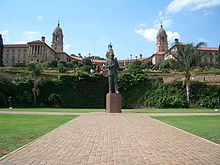Barry Hertzog
James Barry Munnik Hertzog (born April 3, 1866 near Wellington , Cape Colony ; † November 21, 1942 in Pretoria , South Africa ) was a Boer general and Prime Minister of the Union of South Africa from 1924 to 1939 .
Military career
Hertzog received his legal qualification from Victoria College in Stellenbosch , Cape Colony, and the University of Amsterdam . From 1892 he had a law firm in Pretoria until he was appointed to the High Court of the Orange Free State in 1895 . During the Boer War (1899–1902) he rose to general and was deputy commander of the military forces of the Orange Free State. Despite some military difficulties, he became known as the daring and inventive leader of the guerrilla warriors who fought the British. Finally he was convinced of the futility of further bloodshed and in May 1902 he signed the Treaty of Vereeniging .
Political career
After the Second Boer War, Hertzog went into politics and became the chief organizer of the Orangia Unie Party . In 1907 the Orange River Colony became self-governing, and Hertzog joined the Cabinet as Attorney General and Secretary of Education. Against stiff resistance, he insisted that in addition to English, Afrikaans should be taught in schools. When the new nation was formed as the South African Union in 1910, he became Minister of Justice. He held this position until 1912. An aversion to British expansionism and to Prime Minister Louis Botha led to a ministerial crisis. In 1913 he led the Old Boer and the anti-British faction to split off from the South African Party .
When the Maritz Rebellion broke out in 1914, he remained neutral. In the following years he led the opposition to the government of Jan Smuts . In the general election in 1924, his National Party defeated the South African Party of Jan Smuts and formed the government. In 1934 the National Party and the South African Party merged to form the United Party .
Hertzog was a Republican who believed in the independence of the South African Union from the British Empire . His government accepted the Westminster Statute , and in 1937, when Edward VIII abdicated as King of the British Empire and thus King of South Africa, Hertzog insisted that the South African Parliament vote for the decision.
On September 4, 1939, the United Party rejected Hertzog's neutral stance on World War II and deposed him in favor of Jan Smuts. Hertzog founded the people 's party, which split up in 1941. A part, especially Hertzog supporters, united with the Gesuiwerde Nasionale Party by Daniel François Malan to form the Herenigde Nasionale Party (HNP). Another part was the African party around Nicolaas Christiaan Havenga .
Monument in Pretoria
A statue of Hertzog was removed by the South African government in 2013 from its original location in front of the Union Buildings government seat in Pretoria to make way for a nine-meter-high statue of Nelson Mandela . In talks with Hertzog's descendants, an agreement had been reached to relocate the Hertzog monument to another location within the building complex, announced President Jacob Zuma .
literature
- Oswald Pirow : James Barry Munnik Hertzog . Timmins, Cape Town 1958.
Web links
- Newspaper article about Barry Hertzog in the 20th century press kit of the ZBW - Leibniz Information Center for Economics .
Individual evidence
- ^ Zuma: Hertzog statue removed after exhaustive consultation process. In: Mail & Guardian of December 16, 2013 (English)
| personal data | |
|---|---|
| SURNAME | Hertzog, Barry |
| ALTERNATIVE NAMES | Hertzog, James Barry Munnik (full name) |
| BRIEF DESCRIPTION | South African general and politician |
| DATE OF BIRTH | April 3, 1866 |
| PLACE OF BIRTH | Wellington |
| DATE OF DEATH | November 21, 1942 |
| Place of death | Pretoria |

